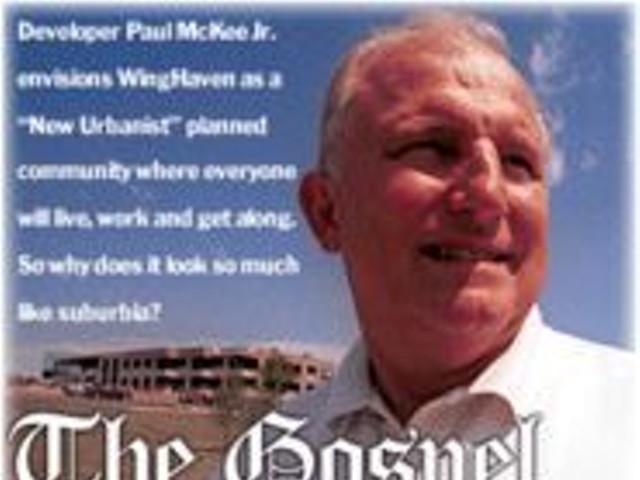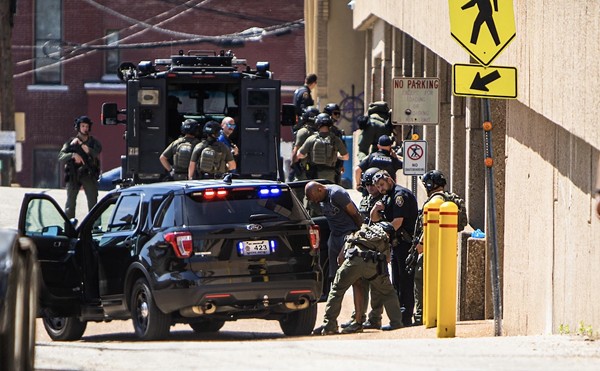Running his finger over the celt's cool surface, he placed it carefully in the northwest section of the pit and laid two more alongside it. Diagonally across, he stacked more celts -- some speckled white, some black; some rounded, some squared. He laid them all tip to butt, parallel to the ground -- except in the southwest section, where he stood them upright, then angled them 45 degrees. He worked steadily, in layers, and he rested the largest celt of all, a foot-and-a-half long with a heft of 25 pounds, atop three layers of three. Carefully he trickled in clean soil to cushion the blades, most of them sharpened, a few not. Then he covered the pit with several inches of silty ochre clay and stood, satisfied.
These 70 stone celts were as valuable to his people as gold to the Incas. And they would lie untouched for 900 years.
The minute the backhoe lifted off the plow layer -- a jumble of black topsoil, corn stubble and clay -- Tim Pauketat knew this site was different. He'd dug five villages already, all in the arc of rolling farmland 10-20 miles from the Cahokia mounds. They'd all been simple places, huts arranged in kinship groups around small courtyards. Yet they'd been built after 1000 A.D., at a time when the central mound civilization was growing more and more sophisticated, stylized and elaborate.
A noted field archaeologist, Pauketat had been studying Cahokia his whole life. As a little boy, he went on dinosaur-hunting expeditions in the fields around Belleville, and he could see the mounds in the distance, feel their spell. For his doctoral dissertation, he'd examined the lifestyles of Cahokia's elite inner circle. Now, working out in the villages, he was intrigued by the signs of resistance, the cultural lag that had kept the farmers clinging to the old ways. They hadn't hankered after Cahokia's exotic crystals and stones, hadn't traveled to the metropolis for gaming or burial rituals. When they made pottery, they incorporated some of Cahokia's brilliant new techniques into the traditional methods, creating what Pauketat describes as "weird hybrid styles, not terribly beautiful but very practical." These villages in the hinterlands might have grown food and butchered deer for the Cahokians, he decided, but they'd remained loyal to their own simple, traditional lifeworld.
This summer, he started digging at yet another rural site, high on a hill in a cornfield near O'Fallon, Ill. A professor at the University of Illinois' Urbana-Champaign campus, Pauketat had a National Science Foundation grant for the dig and about 20 students in his field school. He was expecting to find another simple village.
Then the backhoe laid bare the dark-stained outline of "as densely packed a village as I've ever seen," says Pauketat. "The houses were practically on top of each other." They were big, too, some almost 5 by 9 meters, twice the size of the huts in the other villages. Instead of standing in a loose arrangement, 5 or 6 yards apart, they were as close as 2 feet, lined up in neat rows. Instead of kinship groups, there was a single central courtyard. Instead of a ragged natural boundary, the village had four straight sides.
Pauketat thought immediately of the four corners, an arrangement used again and again at Cahokia to reference cosmological order.
A month later, the researchers had about 50 of the 100-200 houses plotted, and they'd already found more decorative Cahokia artifacts than they'd unearthed at any of the other villages. This place was nothing like the other villages, that much was obvious, but they still hadn't fathomed its structure or its purpose. Then, one blazing-hot morning, Pauketat stood in the middle of the site, staring at their map. He looked around at the roped-off sections of ground. He looked back down at the map. And suddenly everything clicked into place.
An invisible axis ran straight through the central courtyard, cutting the village in half. All the houses on the west side of that axis were oriented east-west. All the houses on the east side (except one, joke of the gods) were oriented north-south. The two unusual T-shaped structures with formal entryways fell on the axis. So did a line of holes for massive poles, 2 feet across instead of the usual 6-8 inches. "There were so many patterns," says Pauketat, now convinced that this was another sort of village altogether, its order planned and imposed, its organization sophisticated. "I think there were ordinary villagers living there, but I also think there was someone else." Someone of status. Someone who'd come directly from Cahokia.
He squinted into the distance: They could have seen Cahokia's mounds from this hill; they could even have seen the largest of the 26 mounds across the Mississippi in what's now St. Louis. Pauketat's heart raced. Ever since grad school, he'd been looking for clues to political power, "how it is that people allow themselves to be lorded over by other people." By digging deep into the past, he found, he could strip away the complexities of today's bureaucratic machinery and see power's immediate effects. He'd looked at how the higher-ups lived, whether they ate better than the rest, whether they networked with other tribes. Then he'd stumbled into the villages in the hinterlands, alerted in 1995 by the discovery of a pre-Columbian sandstone smoking pipe on the construction site of a new subdivision. Now he'd dug up what amounted to a gated community, an unusually sophisticated rural outpost with close ties to the center of power.
And there was more to be found.
On Friday, July 13, a 19-year-old student named Nick Wisseman was casting about for the east trench of a house. Drenched with sweat and cursing an elbow swollen with bursitis, he slid his trowel too far -- and scraped rock. Slid it more carefully and dug out a large stone celt. Found three more in rapid succession. Called his supervisor over, trying to sound professional and matter-of-fact.
The supervisor took one look and went to get Pauketat, who was giving a tour to some college students from Carbondale. He waved, said he'd be over as soon as he finished. Wisseman waited half-an-hour, breathless. This was his first dig, and so far there'd been what he describes as "a fair amount of precision, even tedium": learning to map the site to within a centimeter, screening sticky clay through fine mesh, finding maybe a tiny spear point. But finding a celt, that was a big deal. And finding four of them in one place....
Finally Pauketat came over, examined the celts and, intense as a brain surgeon prepping, told Wisseman to clean the entire area. The cache fell right on the axis that bisected the village, and Pauketat knew it mattered. "We're going to have to dig this out today," he warned, "so someone wandering through doesn't loot it out."
Wisseman nodded eagerly, the pain in his elbow long forgotten. Site immaculate, he went back to digging, unearthing the massive foot-and-a-half celt and dozens more after it. They were all horizontal, flat against the earth. Then he reached the southwest section and saw one angled down into the ground, and he realized there could be layers of them. "Mother lode!" he muttered.
Soon they were all digging, working in teams of six. By dark, each celt had to be exposed, mapped and photographed in situ. The celts were packed tight, with very little soil around them, so to avoid making slash marks they set aside their trowels and used chopsticks. As each celt was removed, the site manager's 10-year-old daughter called out the running total.
As it sailed into the 30s, she lost count. By the time they hit the final total of 70, the whole team was staring at each other in disbelief. "You tend to have dreams of finding piles of artifacts," admits Pauketat, "and people kept commenting that this felt like a dream." The only cache larger than this one had been found in the late 1800s and immediately dispersed. Theirs would be preserved intact.
They stayed well into the evening, filling half-a-dozen 5-gallon buckets with the heavy celts. They were big, and all but three were pristine, never used at all. Ceremonial burial, Pauketat realized swiftly. This was his clincher: proof that the site had indeed been a special and important place, occupied by someone of such high status that he could afford to simply bury 70 valuable tools.
Ceremonial burials were a common, if mysterious, practice, and many archaeologists already agree with Pauketat's conclusions about the cache. But Bill Iseminger, curator of the Cahokia Mounds State Historic Site, says it's possible the villagers were manufacturing or distributing the celts, and Larry Kinsella, a retired carpenter who volunteered at the site, can't fathom why anybody would make a tool just to bury it. "Tools are made to be used," he insists. "I make these, and I cut trees with them. My best guess is that these were on their way to Cahokia, to the Cahokia Mounds Construction Co. or something. I think they are connected with massive building of canoes and stockades."
As for that 25-pound celt Pauketat insists was too unwieldy for use, Kinsella's determined to find a stone that big, make one himself and try chopping tree limbs with it. Meanwhile, he's going to start making his own celts larger; he says these are all twice the size of the celts he's been copying.
"That's because they were ceremonial," groans Pauketat. "Some of these were sharpened in ways that meant they never could have been used. The idea that someone buried them and forgot is pretty weak. If they were going to come back for them, they would have made them to be usable. But it was common to include unfinished items in a ceremonial burial. And the pit was intentional: It was filled with dirt but no debris."
The celts will go on public display for the first time at the annual Rediscover Cahokia celebration, Sept. 8 and 9 at Cahokia Mounds. After the exhibit, their future's as uncertain as their past. "Archaeologists haven't seen a group of new celts like this before," notes Pauketat. "It's causing a lot of commotion. Cahokia's clamoring to get them intact."
The rest of the site's secrets wait in the abandoned cornfield, hidden until next summer's dig. Someone's already cut the yellow caution tape, and Pauketat will brood until spring over the chances of vandalism. He's hoping to interest National Geographic in funding the dig next year.
If burying the celts was a sign of status, maybe digging them up will shake loose some power.





